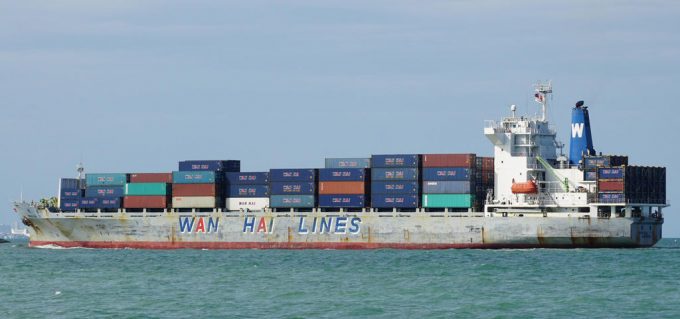Liner schedule reliability improving, but late ships are arriving even later
Despite several mainline trades continuing to be marred by issues of port congestion and equipment ...
TFII: SOLID AS USUALMAERSK: WEAKENINGF: FALLING OFF A CLIFFAAPL: 'BOTTLENECK IN MAINLAND CHINA'AAPL: CHINA TRENDSDHL: GROWTH CAPEXR: ANOTHER SOLID DELIVERYMFT: HERE COMES THE FALLDSV: LOOK AT SCHENKER PERFORMANCEUPS: A WAVE OF DOWNGRADES DSV: BARGAIN BINKNX: EARNINGS OUTODFL: RISING AND FALLING AND THEN RISING
TFII: SOLID AS USUALMAERSK: WEAKENINGF: FALLING OFF A CLIFFAAPL: 'BOTTLENECK IN MAINLAND CHINA'AAPL: CHINA TRENDSDHL: GROWTH CAPEXR: ANOTHER SOLID DELIVERYMFT: HERE COMES THE FALLDSV: LOOK AT SCHENKER PERFORMANCEUPS: A WAVE OF DOWNGRADES DSV: BARGAIN BINKNX: EARNINGS OUTODFL: RISING AND FALLING AND THEN RISING

Wan Hai Lines has become the first liner operator to take a big step to reduce its tonnage overhang.
The Taiwanese company is putting up 10 older ships for scrap and is inviting cash buyers to submit tenders by Friday (16 December).
The Loadstar was informed that Wan Hai is selling four 1,088 teu 160-type ships built between 1996 and 1998, the Wan Hai 161, 162, 163 and 165, as well as six 1994-built 1,368 teu, 200-type ships, Wan Hai 215, 216, 221, 222, 223 and 225. They are the oldest among Wan Hai’s 112 owned fleet
The chosen buyers must send the vessels to environmentally friendly ship recycling yards that meet Wan Hai’s ESG requirements.
Wan Hai, now the 11th-largest liner operator, had planned to replace its older ships in 2020 and ordered 24 3,000 teu ships from Japanese shipyards. The carrier also purchased several second-hand ships.
However, the Covid-19 pandemic caused severe logistical bottlenecks around the world and a severe shortage of capacity and Wan Hai delayed its plan to demolish its older ships to provide customers with sufficient shipping slots.
VesselsValue estimates the combined value of the scrapped ships at around $43m.
Wan Hai’s move to scrap ships coincides with shrinking earnings and cargo volumes in the container sector. The company’s Q3 net profit fell 37% year on year, to $718.3m, although higher turnover in the first six months of the year meant cumulative net profit for January-September was up 34% year on year, at $3bn.
General manager Tommy Hsieh expects Wan Hai to remain in the black this year, as half of its contracts with US clients were signed on a long-term basis and are protected by fixed freight rates.
In September, Thai operator Regional Container Lines broke a nine-month drought of containership demolition when it sold the 1990-built 1,248 teu Mathu Bhum for recycling.
There are approximately 5,600 fully cellular ships, with a total capacity of 25.5m teu, in the active fleet. Of these, only 77, with a capacity of 121,671 teu, are aged at least 30 years, while there are 347 units of 533,478 teu aged 25-29 years and 678 ships of 1.85m teu aged 20-24 years.
Comment on this article